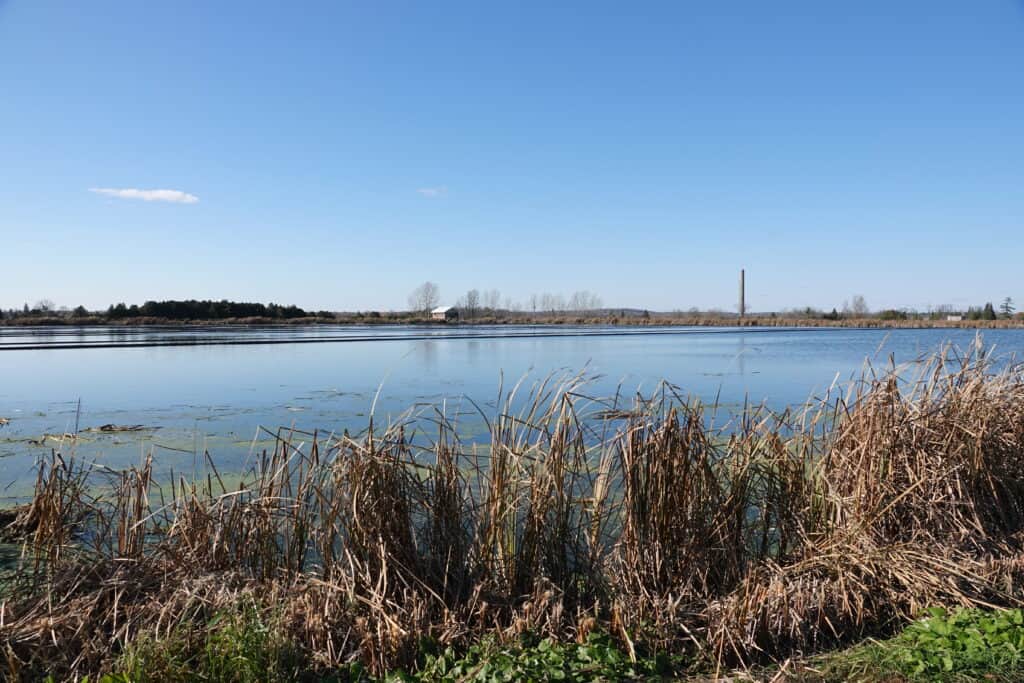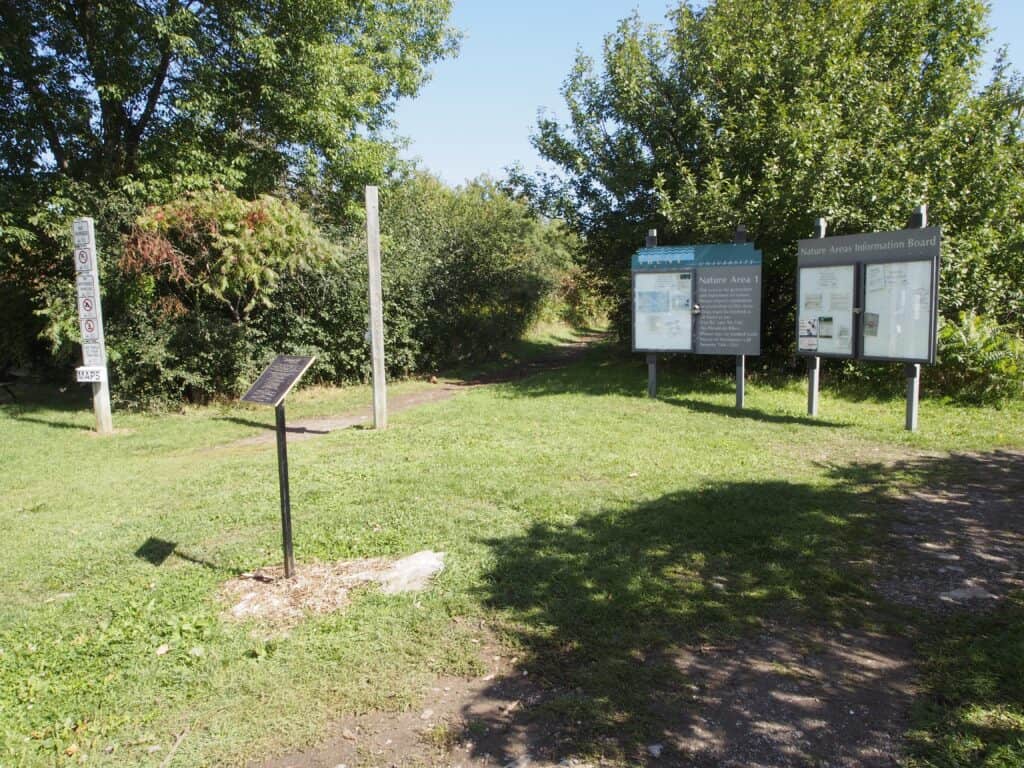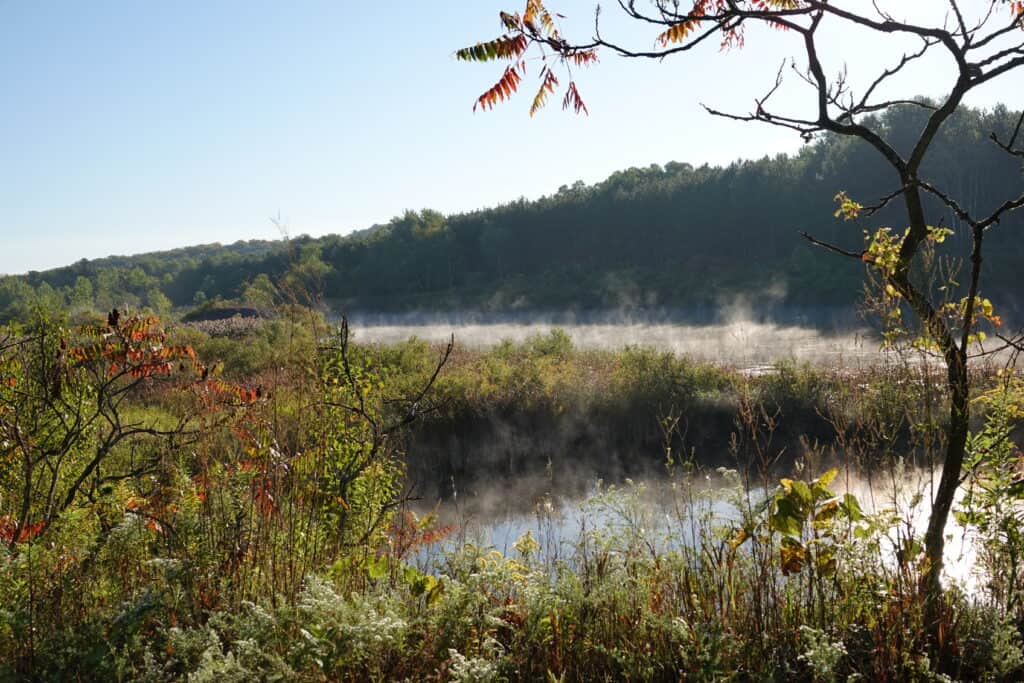Fifteen birding hotspots in Peterborough and the Kawarthas (and two great apps!)
Peterborough Examiner – May 12, 2023 – by Drew Monkman
With mid-May comes peak songbird migration as multitudes of warblers, vireos, flycatchers, tanagers, orioles and more arrive from Latin America. Some of these birds will stay to nest in our area while others will continue further north. This week I’d like to present some of my favourite destinations to see both migrants and birds that will remain to nest here. By visiting several of these locations, you can often find 75 or more species in one day. Almost all are excellent during fall migration, too.
If you decide to check out some of these hotspots, you can greatly increase your chances of hearing – and then seeing – many of the birds by using the Sound ID feature on the free Merlin bird app. Merlin will instantly start listing the birds it hears. Each time a given bird sings, the name lights up in yellow. If Merlin has trouble “hearing” and identifying your bird, try getting closer.
For each location, I’ve highlighted some of the more noteworthy birds that are usually found there in May, June and early July. Nearly all of these locations are also good for the common warblers (yellow, common yellowthroat and American redstart), the common vireos (warbling and red-eyed), the common sparrows (song, swamp, chipping), and common backyard birds (chickadees, nuthatches, house wrens, downy woodpecker, etc.).
To see a complete list of all of the birds that have been recorded at these destinations, go to ebird.org. Click on Explore. Type “Peterborough” in the Explore Regions box. Click on Hotspots at the top and then the destination of your choice. On the left side of the screen, choose Bar Charts. You will see a list of all of the birds that have been seen there, along with their seasonal abundance. The thicker the bar, the more common the bird is.
Be sure to create a free account with eBird and to submit a checklist for each area you visit. Your sightings are important for bird conservation. To learn how to use eBird, go to https://support.ebird.org/en/support/home
1. Lakefield Sewage Lagoons: With 224 species recorded here, the lagoons are the number one birding hotspot in Peterborough County and worth a visit at almost any time of year. They are located on the southeastern edge of Lakefield. Turn east off Co. Rd. 32 (River Rd.) onto Co. Rd. 33 and continue for about half a kilometre. The parking lot is on the right. The gate is usually locked, but the municipality allows birders to access the site provided that you don’t park in front of the entrance gate. Park parallel to the fence on the west (right) side or along the south side of the road where there is space for several vehicles. You can walk in from either side of the parking lot on small paths. Municipal employees usually leave the gate open during their service visits, but under no circumstances should birders drive their vehicles past the open gate. Walk along the gravel berm road around the two lagoons while birding here.
Both lagoons are worth checking out but most of the ducks are in the south cell. The adjacent woods and fields are excellent for birds, as well. If you have a spotting scope, be sure to take it along. Highlights: Wood duck, blue-winged teal, northern shoveler, green-winged teal, hooded merganser, spotted sandpiper, black tern, green heron, tree swallows (nesting in boxes), eastern meadowlark, etc.
2. Imagine the Marsh Conservation Area: Also known as the Lakefield Marsh, this wetland is located at the south end of Lake Katchewanooka. Turn north off Co. Rd. 29 (Bridge St.) onto Clement St. Turn right on D’Eyncourt St. and follow the signs. Visit the viewing tower and then walk along the trail to the end of the point. Highlights: Trumpeter and/or mute swans, American bittern, great blue heron, osprey, northern harrier, bald eagle, belted kingfisher, marsh wren, swamp sparrow, common yellowthroat, etc.
3. Sawer Creek Wetland: Follow Hwy 28 north almost to Lakefield. Turn east on Strickland Rd. and then north on Douro Fifth Line. Turn east on Lynch’s Rock Rd. and follow to the Sawer Creek Wetland Wildlife Area. Highlights: Least bittern, sandhill cranes, Wilson’s snipe, alder flycatcher, marsh wren, etc.
4. Ingleton-Wells Property (Kawartha Land Trust): Follow Hwy 28 north from Burleigh Falls to Mt. Julian Viamede Rd. Turn right and continue to Reid’s Rd. Park at address marker 105. There are 10 km of well-marked, interconnected trails with benches. The best birding is on the yellow and brown trails. Highlights: Red-shouldered hawk, broad-winged hawk, Eastern bluebird, golden-winged warbler, blue-winged warbler, mourning warbler, indigo bunting, etc.
5. Hubble Road: Follow Co. Rd. 6 along the south shore of Stony Lake and turn right at Co. Rd. 44. Continue southeast for about 4 km to Hubble Rd. This woodland and alvar-like habitat is home to many less common birds. Highlights: Red-shouldered hawk, broad-winged hawk, whip-poor-will, eastern towhee, golden-winged warbler, etc.
6. Rotary-Greenway Trail: The section from Trent University to Douro Ninth Line is especially good. Highlights: Green heron, alder flycatcher, willow flycatcher, great crested flycatcher, eastern kingbird, wood thrush, savannah sparrow, bobolink, black-and-white warbler, chestnut-sided warbler, pine warbler, black-throated green warbler, indigo bunting, rose-breasted grosbeak, etc.
7. Trent University Wildlife Sanctuary: Located on the east side of University Rd., the numerous trails traverse a variety of habitats. Highlights: Red-headed woodpecker, eastern wood-pewee, winter wren, brown thrasher, veery, field sparrow, white-throated sparrow, ovenbird, northern waterthrush, etc.
8. Trent University South Drumlin Nature Area: Enter off of Scollard Dr. just north of Cunningham Blvd. and take the short path up to the dam at Thompson Bay. Follow the path north. Stay to the right to walk along the edge of the canal. Just before Nassau Mills Rd., take the path up the hill on the left to loop back through the woods. Highlights: Trumpeter swan, cliff swallow, Baltimore oriole, yellow-bellied sapsucker, eastern wood-pewee, great crested flycatcher, brown thrasher, field sparrow, black-and-white warbler, etc.
9. Meadowvale Park: Enter from the west end of Frances Stewart Rd. at Ashdale Cres. W. The park extends west of the Rotary Greenway Trail. Highlights: Chimney swift, great blue heron, eastern kingbird, American redstart, yellow warbler, warbling vireo, gray catbird, etc.
10. Rotary Park: The park is located in Peterborough on the east side of the London St. Footbridge. Highlights: Chimney swift, osprey, belted kingfisher, merlin, eastern kingbird, and the common vireos and warblers. Peregrine falcons are sometimes seen here.
11. Beavermead Park: Located on Ashburnham Dr., Beavermead is the number two birding hotspot in Peterborough County with 198 species recorded. It is especially good during migration when a wide variety of warblers and other songbirds like scarlet tanagers often turn up. The best locations include the Tollington Bridge area, the campground and Ecology Park. Highlights: belted kingfisher, eastern wood-pewee, Baltimore oriole, northern flicker, and the common vireos and warblers.
12. Fairbairn Street Wetland: This little-known wetland is located on the west side of Fairbairn St., just north of Co. Rd. 19 (Line Rd. 3). Early morning and evening are the best times to visit. Highlights: Virginia rail, sora, common gallinule, American bittern, green heron, swamp sparrow, etc.
13. Mervin Line: Follow Airport Rd south of the Hwy 7 By-pass to Mervin Line. Turn east and park at Moncrief Line. Walk towards the Otonabee River until you arrive in a large silver maple swamp. Highlights: wood duck, green heron, red-bellied woodpecker, least flycatcher, brown creeper, blue-gray gnatcatcher, northern waterthrush, etc.
14. Otonabee Gravel Pit Conservation Area: This number three hotspot (195 species) is located at the south end of Crowley Line where Crowley turns west and becomes Rosa Landing Road. Walk in along the unmaintained road allowance, which continues south. Enter at gate on left. Continue until you arrive at a large open area with ponds. These ponds attract migrating shorebirds in late summer and fall. Highlights: wood duck, hooded merganser, ruffed grouse, killdeer, Wilson’s snipe, yellow-bellied sapsucker, red-bellied woodpecker, eastern wood-pewee, great crested flycatcher, veery, scarlet tanager, ovenbird, etc.
15. Lang-Hastings Trail: The entire trail from Peterborough to Hastings is worth walking or biking. Along the section between Technology Dr. and Co. Rd. 35, watch and listen for Virginia rail, least bittern, green heron, willow flycatcher, alder flycatcher, and marsh wren. Between Blezard Line and Co. Rd. 38, some highlights include bobolink, ovenbird, mourning warbler, chestnut-sided warbler and scarlet tanager.


